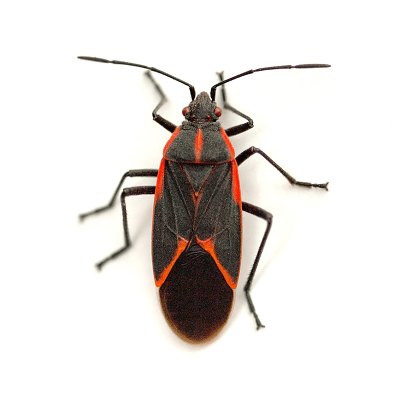
Color: Bright red or black, with narrow reddish lines on the back.
Size: ½” (12 mm) long.
Found crawling on the outside walls of homes and other buildings, and many will find their way inside Wall voids or attics.
Pests include box elder bugs, cluster flies, and lady beetles. As the weather cools in late summer and early fall, the sun warms the southern and western walls of buildings. The warmth attracts these insects to buildings where they crawl inside cracks and stay there for the winter. This would be fine, but during warm winter days, some insects "wake up" and end up on the inside of the building.
Sucking juices from the Boxelder tree, feed on seed, foliage, and twigs.
Boxelder bugs are primarily a nuisance because they enter homes and other buildings, often in large numbers. Fortunately, they do not bite people and are essentially harmless to property. When abundant, they can stain walls, curtains, and other surfaces with their excrement. Occasionally some may seek moisture and may be found around houseplants, although they rarely attack them. In the few cases when they do feed, boxelder bugs are very unlikely to injure indoor plants
Outdoors
The best management of boxelder bugs is prevention -- take steps to keep them from entering your home from the start. You can partly do this through exclusion though it largely depends on how your home was constructed. Make any repairs by the end of August.
For all homes
- Repair or replace damaged window and door screens.
- Repair or replace damaged screens in roof and soffit vents, and in bathroom and kitchen fans.
- Seal areas where cable TV wires, phone lines, and other utility wires and pipes, outdoor facets, dryer vents and similar objects enter buildings.
- Seal with caulk or for larger spaces use polyurethane expandable spray foam, copper mesh, or other appropriate sealant.
- Install door sweeps or thresholds to all exterior entry doors. Install a rubber seal along the bottom of garage doors.
For homes constructed of stucco, plaster, stone or brick veneer
- Check the outside surfaces for spaces and cracks that may allow insects easy entry, sealing any openings 1/8 th inch in size or larger. This will not eliminate all boxelder bugs but it can significantly reduce the number entering buildings.
- Seal cracks and spaces around doors, windows, roof lines, and fascia boards and other areas where vertical surfaces meet horizontal ones.
- Also check for gaps and cracks where different materials meet, such as brick and wood siding. Seal cracks with caulk, such as silicone, elastometric latex, or silicone/acrylic.
- For stone or brick veneer, the bottom of the walls will have 'weep holes' and these must not be sealed up. Instead, visit a local hardware store and request ventilation plugs that can be installed in these weep holes.
For homes constructed of vinyl siding
- Unfortunately, houses with vinyl siding provide too many gaps to effectively exclude these insects. These houses are designed for aesthetics, durability, and energy efficiency. Relative to excluding insects, the benefit of these houses is that they are often effectively sealed with a 'house wrap' placed underneath the siding.
- For these types of houses, concentrate on the recommendations provided for all houses and use an insecticide on areas where these bugs have congregated in the past. In our experience, large numbers collecting around the doors and other entryways are often the most prevalent means of entry during the fall.
Manufacturer Recommended Products And Treatment For Boxelder Bug Control
Pests need food, water, and shelter. Often the problem may be solved just by removing these key items. Before even thinking about chemical pest control, it is important to be aware of
| Conducive Condition | Recommendation | |
| 1 | Tree branches on house | Keep tree branches away from house to reduce pest access |
| 2 | Firewood next to foundation | Keep firewood away from house to reduce pest harborage |
| 3 | Debris on crawlspace/next to foundation | Remove wood debris to reduce termite ha rborage area |
| 4 | Excessive plant cover, stump, etc. | Providing spacing between plant cover and structure |
| 5 | Soil above the foundation Ii ne | Keep soil below top of foundation to reduce harbo rage areas |
| 6 | Wood-to-ground contact | Keep soil from touching wood to eliminate termite access |
| 7 | Debris on roof/full gutter | Keep gutter & roof free of debris to reduce insect harborage |
| 8 | Standi ng water near/under structure | Eli minate standing water to reduce pest harbo rage |
| 9 | Mo isture problem under structure | Increase ventilation to reduce pest harbo rage area |
| 10 | Openi ngs at plumbi ng & electronics | Seal opening to reduce pest access |
| 11 | Excessive gaps at windows/doors | Seal gaps to reduce pest access |
| 12 | Lea ky plumb ing fixtures | Repair to reduce moisture for pests |
| 13 | Keep garbage cans covered | Covered to reduce attraction of insects of vertebrate pests |
| 14 | Mo isture damage wood | Repair rotten or damaged wood to reduce insect harborage |
| 15 | Grocery bags stored improperly | Seal paper sacks in containers to reduce i nsect ha rborage areas |
| 16 | Pet food unsealed or left out | Keep pet food in sealed containers and unavailable to pests |
| 17 | Excessive storage conditions | Keep storage areas uncluttered and manageable |
| 18 | Debris below kick plates | Remove kick plates to reduce rodent harborage |
2 products



